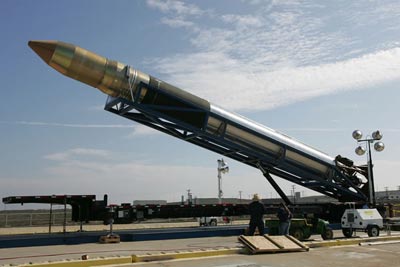Physics, economics, and reality, part deuxA different look at the challenges of spaceflightby Joe Latrell
|
| The eagerness of a lot space companies leads to poor choices of financial partners and a greater difficulty of success. |
A second issue revolves around the RLVs in particular. The number of flights being asked for by each RLV is on the order of 100. So far, nothing has been built that can really survive this many space flights. If the ships are to be used as frequently as is proposed (100 flights per year for 10 years) each vehicle has to be refurbished and flight-ready every five weeks. Should something go wrong with a craft in the pipeline, there is no easy way to recover the timetable. While it would be more expensive, the need for backup vehicles should be considered as well as expanding the initial fleet. RLVs should be thought of as having “limited reusability” rather than expecting the craft to live indefinitely, say through 100 or more flights each. To date, the best flight record was the shuttle Columbia. She didn’t make it to 40 flights.
The eagerness of a lot space companies leads to poor choices of financial partners and a greater difficulty of success. Venture capital, as some say, is like a marriage without the benefits, and their paper presents this aspect of company building, too. It is surprising how much of a delicate balancing act creating a business plan really is. The company wants flexibility and the venture capital groups (VCs) want rigidity. They want to know that you have thought things out. While I grant that every company should have a good plan with a set of goals, the company needs to be fast on its feet. New innovations may change the way business is done. You may see your great plans crumble because the markets didn’t materialize as predicted. If you cannot adapt, you die. When things go wrong and the company cannot hit its projected revenue targets, many VCs are ready to gut the management and salvage what they can. However, balance is everything in the business plan game. You must have the numbers ready and have the plan in place but stress that things in the spaceflight game change quickly. Find a VC who can accept these issues. Better yet, find a way to fund your company without the partner at all or in a limited combination of investment and sales.
Many of the problems that this paper is trying to point out are the external factors to the company. While you might create a spacecraft that costs only ten dollars to fly, you still must deal with issues beyond your control. Range operations and insurance are the big ones and they will sink a company faster than having no funding at all.
Range operations today are very meticulous, very careful, very safety minded, and in a nutshell, slow. They don’t want their insurance to go up any more than you want yours to increase. Most of the “spaceports” are still government operated and so operate at government speeds. You may want to launch twice a week, but will the range really allow it? Will it stress their infrastructure beyond their limits? The argument put forth by the space community is that spaceports will adapt, but they aren’t going to change the way they do business for one small customer or even two. Spaceport managers have heard the promises of the past (poisoning the pond) and are leery of anyone who says they will launch as planned, especially on a high-volume basis. The space community also argues that new spaceports will be online to handle the rush of new launch companies. The reality is if you are planning a space program for 2007, you had better have a spaceport lined up and ready to take your money—lots of it. Sam, John, and David nailed this point perfectly.
| Range operations today are very meticulous, very careful, very safety minded, and in a nutshell, slow. They don’t want their insurance to go up any more than you want yours to increase. |
They likewise hit a perfect 10 with the insurance. If you want a fun exercise, try calling an agent and tell them you want to insure a rocket flight. Brace yourself as you get one of three responses, “We don’t do that.” “You want to do what?” and [click]. I can tell you it is not a pleasant experience. My experience involved calling 23 companies before getting someone who took my company seriously.
My final quibble with the material is the attempt to somehow tie all of this orbital talk to suborbital markets. Providing that hook in the conclusion without any supporting data in the text is known as a literary fallacy. If you are going to talk about orbital, talk orbital. If you are going to link it to the suborbital market, your text should reflect that with facts, figures, charts, etc.
Despite the grievances I have with this paper, it is overall a good primer for someone looking at the external forces that affect space-related companies. It should be required reading for everyone interested in pursuing a career in the commercial space business. The facts are good, even if they are a bit simplistic. The references sited should also be required reading. There is a lot of good information tucked away there. Just remember that space is a bit trickier than either of these papers cover. Be ready for anything, but most of all believe. It’s going to happen.
